
1) Natural geography
|
Area > Comparative to US places |
||
|
Capital city with population |
Tunis - 887,800 |
|
|
Forested Land |
3.1% |
[174th of 193] |
|
Geographic coordinates |
34 00 N, 9 00 E |
|
|
land border lengths > T-V > Number of neighbours |
2 |
[12th of 16] |
|
land border lengths > T-V > Total Borders |
1,424 km |
[14th of 16] |
|
Largest city |
Tunis |
|
|
Largest city population |
1,722,000 |
[60th of 174] |
|
Largest city with population |
Tunis - 887,800 |
|
|
northernmost point > Latitude |
37°21'N |
|
|
Population density |
61.24 people per sqkm |
[130th of 256] |
|
Population density > people per sq. km |
64.55 people/m² |
[116th of 204] |
|
Precipitation |
466 mm |
[73rd of 95] |
|
Rural population density > rural population per sq. km of arable land |
125.06 people/km² of arable lan |
[140th of 188] |
|
Surface area > sq. km |
163,610 km² |
[90th of 206] |
|
tallest mountains > Mountain |
Jebel ech Chambi |
|
SOURCES All CIA World Factbooks 18
December 2003 to 18 December 2008; United Nations World Statistics Pocketbook
and Statistical Yearbook, City Population, CIA World Factbook, World Gazetteer,
Official government websites.; FAO; Wikipedia List of land border lengths ;
United Nations World Statistics Pocketbook and Statistical Yearbook; Wikipedia
List of countries by northernmost point ; Heal The World Foundation.; World
Development Indicators database; Wikipedia List of tallest mountains by country
ALTERNATIVE NAMES
Tunisia, Tunisian Republic, Al Jumhuriyah at Tunisiyah, Tunis
Environment
|
Adjusted savings net forest depletion > % of GNI |
0.09 % of GNI |
[48th of 57] |
|
Areas under protection |
7 |
[123rd of 146] |
|
Carbon efficiency |
1.17 CO2 emissions/$ GDP |
[69th of 141] |
|
CO2 Emissions |
20,179.1 |
[71st of 178] |
|
Ecological footprint |
2.27 |
[68th of 141] |
|
Endangered species protection |
100% |
[9th of 141] |
|
Forest area > % of land area |
6.8 % of land area |
[160th of 195] |
|
Forest area > sq. km |
10,560 km² |
[118th of 195] |
|
Known mammal species |
78 |
[111st of 145] |
|
NOx emissions per populated area |
0.22 thousand metric tons/squ |
[73rd of 141] |
|
Pollution > Carbon dioxide 1999 |
4,771 |
[77th of 199] |
|
Protected area |
0.3 |
[138th of 147] |
|
SO2 emissions per populated area |
1,610 thousand metric tons/squ |
[40th of 141] |
|
Threatened species |
24 |
[82nd of 158] |
|
Threatened species > Mammal |
11 |
[71st of 160] |
|
Water > Availability |
0.22 thousand cubic metres |
[129th of 141] |
|
Water > Dissolved oxygen concentration |
9.35 mls/litre |
[31st of 141] |
|
Water > Freshwater pollution |
11.4 tons/cubic km |
[3rd of 69] |
|
Water pollution, wood industry > % of total BOD emissions |
1.87 % |
[21st of 114] |
|
Wildness |
26.2% |
[41st of 141] |
SOURCES World Development
Indicators database; World Resources Institute; Carbon Dioxide Information
Analysis Center; World Resources Institute. 2003. Carbon Emissions from energy
use and cement manufacturing, 1850 to 2000. Available on-line through the
Climate Analysis Indicators Tool (CAIT) at Washington, DC World Resources
Institute; World Wide Fund for Nature (WWF), Living Planet Report 2000, Gland,
Switzerland 2000, and Redefining Progress.; Convention on International Trade in
Endangered Species of Wild Fauna and Flora, Report on National Reports Required
Under Article VIII, Paragraph 7(a), of the Convention, Eleventh Meeting of the
Conference of the Parties, Gigiri, Kenya, April 2000; Intergovernmental Panel on
Climate Change Special Report on Emissions Scenarios, Data Version 1.1,
B1Illustrative Marker Scenario with model IMAGE; Gregg Marland, Tom Boden, and
Bob Andres, University of North Dakota, via net publication; Jacaranda Atlas;
United Nations World Statistics Pocketbook and Statistical Yearbook; Center for
Environmental Systems Research, University of Kassel, WaterGAP 2.1B, 2001 via
ciesin.org; United Nations Environment Programme (UNEP), Global Environmental
Monitoring System/Water Quality Monitoring System, with data for an additional
29 countries from Prescott-Allen,R. The Well being of Nations, Washington, DC
Island Press, 2001; World Bank, World Development Indicators 2001, Washington,
DC World Bank, 2001 (for BOD emissions)and Center for Environmental Systems
Research, University of Kassel, WaterGap 2.1, 2000 (for data on waterquantity).
via ciesin.org; Wild Areas Project (WAP), joint Wildlife Conservation Society
(WCS) and CIESIN project to map the lastwild places on the earth's surface. via
ciesin.org
ALTERNATIVE NAMES
Tunisia, Tunisian Republic, Al Jumhuriyah at Tunisiyah, Tunis
2) Human geography
Age distribution
Tunisia Population Pyramid for 1990
Age and sex distribution for the year
1990
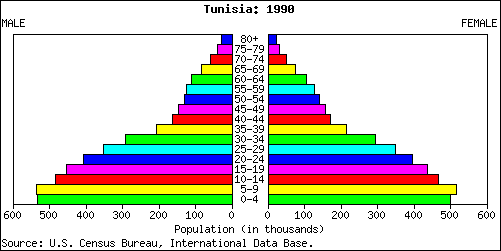
Tunisia Population Pyramid for 1995
Age and sex distribution for the year 1995
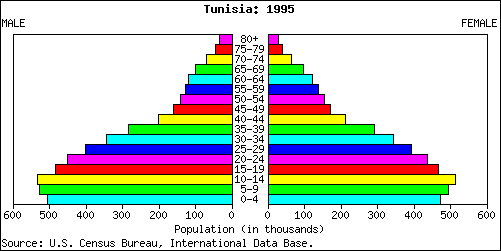
Tunisia Population Pyramid for 2000
Age and sex distribution for the year 2000
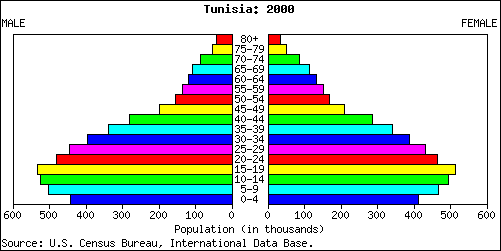
Tunisia Population Pyramid for 2003
Age and sex distribution for the year 2003
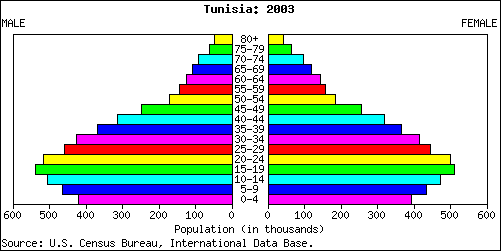
Tunisia Population Pyramid for 2005
Age and sex distribution for the year 2005
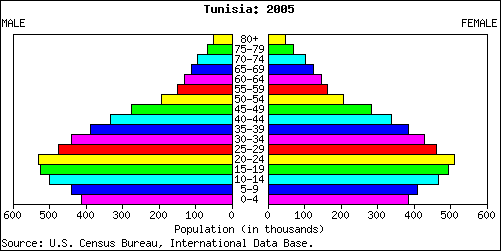
Tunisia Population Pyramid for 2010
Age and sex distribution for the year 2010
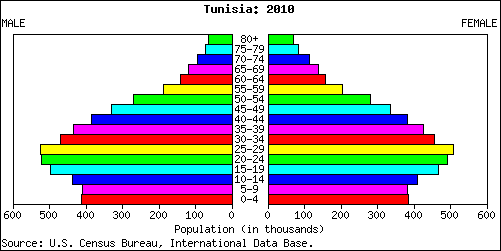
Tunisia Population Pyramid for 2020
Predicted age and sex distribution for the year 2020
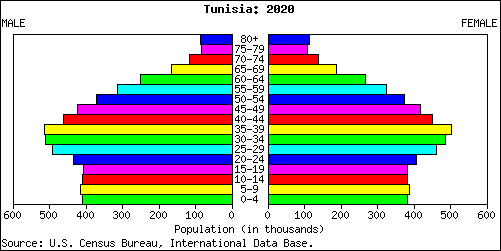
Tunisia Population Pyramid for 2050
Predicted age and sex distribution for the year 2050
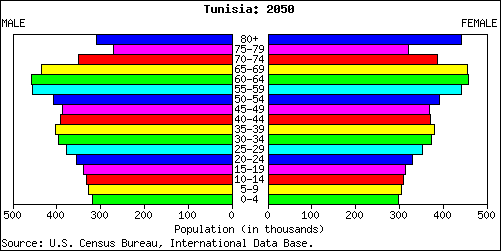
Source US Census Bureau
July 17, 2003
Labor
|
Compensation of employees > % of expense |
39.05 % |
[13th of 97] |
|
Economic activity > Men aged 65 plus |
28.1 |
[95th of 162] |
|
Female economic activity growth |
12% |
[35th of 156] |
|
Firing cost > weeks of wages |
17.3 weeks of wages |
[135th of 164] |
|
force with secondary education > % of total |
29.7 % |
[35th of 51] |
|
force with tertiary education > % of total |
7.1 % |
[47th of 52] |
|
force, female > % of total labor force |
27.61 % |
[169th of 184] |
|
force, total |
3,847,898 |
[85th of 184] |
|
Labor force > By occupation |
||
|
Parental leave > Paid maternity leave |
30 days |
|
|
Parental leave > Paid paternity leave |
||
|
Regulation |
57 |
[49th of 123] |
|
Regulation > Employment Conditions |
53 |
[100th of 123] |
|
Rigidity of employment index |
46 |
[56th of 166] |
|
Unemployment with secondary education, female > % of female unemployment |
26.6 % |
[37th of 71] |
|
Unemployment, total > % of total labor force |
14.7 % |
[16th of 101] |
|
Unemployment, youth total > % of total labor force ages 15-24 |
30.7 % |
[4th of 77] |
|
Vacation > Minimum vacation time around the world > legally required |
30 work days |
|
|
Workers' remittances and compensation of employees, paid > US$ |
15,000,000 $ |
[117th of 149] |
|
Workers' remittances, receipts > BoP, current US$ |
1,392,750,000 BoP $ |
[26th of 115] |
SOURCES World Development Indicators database; Economic activity rate and economically active population, by sex, thirteen age groups, 1950-2010 (ILO estimates and projections) are data from the International Labour Union (ILO). Source details ILO, Economically Active Population, 1950-2010, fourth edition, diskette database (Geneva, 1997). The latest set of estimates and projections covering the period 1950-2010 (4th edition) was released by ILO in December 1996. These data are updated every five-ten years by ILO and a new set of these data is in preparation; calculated on the basis of data on the economically active population and total population from ILO (International Labour Organization). 2002. Estimates and Projections of the Economically Active Population, 1950-2010, 4th ed., rev. 2. Database. Geneva; All CIA World Factbooks 18 December 2003 to 18 December 2008; Wikipedia Parental leave ; The World Bank Group The original methodology and data come from The Regulation of Labor, by Juan Botero, Simeon Djankov, Rafael La Porta, Florencio Lopez-de-Silanes, and Andrei Shleifer. When using the data, please also cite this paper as a reference.; The World Bank Group The original methodology and data come from The Regulation of Labor, by Juan Botero, Simeon Djankov, Rafael La Porta, Florencio Lopez-de-Silanes, and Andrei Shleifer. When using the data, please also cite this paper as a reference; Wikipedia Vacation
ALTERNATIVE NAMES Tunisia, Tunisian Republic, Al Jumhuriyah at Tunisiyah, Tunis
People
|
Age dependency ratio > dependents to working-age population |
0.47 |
[148th of 185] |
|
Age structure > 0-14 years |
25.3 |
[138th of 226] |
|
Age structure > 15-64 years |
68.1 |
[48th of 226] |
|
Divorce rate |
0.82 per 1,000 people |
[17th of 34] |
|
Gender development |
0.709 |
[79th of 141] |
|
Percentage living in rural areas. |
36% |
[118th of 193] |
|
Percentage living in urban areas |
64% |
[80th of 199] |
|
Population > CIA Factbook |
10,383,577 |
[77th of 240] |
|
Population ages 0-14 > % of total |
25.93 % |
[116th of 185] |
|
Projected population growth |
46.46% |
[76th of 141] |
|
Rural population |
3,480,063 |
[85th of 193] |
|
Sex ratio > 15-64 years |
1.01 |
[92nd of 223] |
|
Total Population |
10,175,014 |
[80th of 227] |
|
Total Population > Female |
5,049,975 |
[82nd of 227] |
|
Total Population > Male |
5,125,039 |
[77th of 227] |
|
Urban population |
6,548,937 |
[66th of 195] |
|
Urbanization |
66 |
[74th of 204] |
|
Urbanization in 2015 |
73.5% |
[51st of 164] |
|
Women > Adult literacy rate females as a % of males |
74 |
[107th of 144] |
|
Women > Life expectancy females as a % of males |
106 |
[100th of 173] |
SOURCES World Development
Indicators database; CIA World Factbook, 28 July 2005; divorcereform.org2004;
Human Development Reports, United Nations 2002; Population Division of the
United Nations Secretariat, World Urbanization Prospects The 2003 Revision, Data
Tables and Highlights. Estimates and projections of urban and rural populations
are made by the Population Division of the United Nations Secretariat and
published every two years. These estimates and projections are based on national
census or survey data that have been evaluated and, whenever necessary, adjusted
for deficiencies and inconsistencies; All CIA World Factbooks 18 December 2003
to 18 December 2008; Population Reference Bureau, 2001 World Population Data
Sheet, Washington, DC PRB, 2001. via ciesin.org; U.S. Census Bureau, Population
Division, International Programs Center Spanish Statistical Institute;
Population Division of the United Nations Secretariat, World Urbanization
Prospects The 2001 Revision, Data Tables and Highlights (ESA/P/WP.173, 20 March
2002); UN (United Nations). 2002. World Urbanization Prospects The 2001
Revision. Department of Economic and Social Affairs, Population Division. New
York; UNICEF
ALTERNATIVE NAMES Tunisia, Tunisian Republic, Al Jumhuriyah at Tunisiyah, Tunis
Mortality
|
immigrant population > Immigrants as percentage of state population |
0.3762 |
[174th of 195] |
|
immigrant population > Number of immigrants |
38,000 |
[142nd of 195] |
|
immigrant population > Percentage of total number of immigrants in the world |
>0.1% |
|
|
Net migration rate |
-0.44 migrant(s)/1,000 populati |
[102nd of 225] |
|
Refugees |
560 |
[93rd of 110] |
|
Refugees > Convention on refugees |
24 Oct 1957 d |
|
|
Refugees > Outflow |
1,000 |
[74th of 76] |
|
US visa lottery winners |
115 US visa lottery winners |
[73rd of 178] |
SOURCES Wikipedia List
of countries by immigrant population ; All CIA World Factbooks 18 December 2003
to 18 December 2008; United Nations World Statistics Pocketbook and Statistical
Yearbook; United Nations Treaty Collection; UNHCR (United Nations High
Commissioner for Refugees). 2002. Correspondence on refugees and internally
displaced persons. February. Geneva.; US Department of State Bureau of Consular
Affairs
ALTERNATIVE NAMES Tunisia, Tunisian Republic, Al Jumhuriyah at Tunisiyah, Tunis
Immigration
|
immigrant population > Immigrants as percentage of state population |
0.3762 |
[174th of 195] |
|
immigrant population > Number of immigrants |
38,000 |
[142nd of 195] |
|
immigrant population > Percentage of total number of immigrants in the world |
>0.1% |
|
|
Net migration rate |
-0.44 migrant(s)/1,000 populati |
[102nd of 225] |
|
Refugees |
560 |
[93rd of 110] |
|
Refugees > Convention on refugees |
24 Oct 1957 d |
|
|
Refugees > Outflow |
1,000 |
[74th of 76] |
|
US visa lottery winners |
115 US visa lottery winners |
[73rd of 178] |
SOURCES Wikipedia List of countries by immigrant population ; All CIA World Factbooks 18 December 2003 to 18 December 2008; United Nations World Statistics Pocketbook and Statistical Yearbook; United Nations Treaty Collection; UNHCR (United Nations High Commissioner for Refugees). 2002. Correspondence on refugees and internally displaced persons. February. Geneva.; US Department of State Bureau of Consular Affairs
ALTERNATIVE NAMES Tunisia, Tunisian Republic, Al Jumhuriyah at Tunisiyah, Tunis